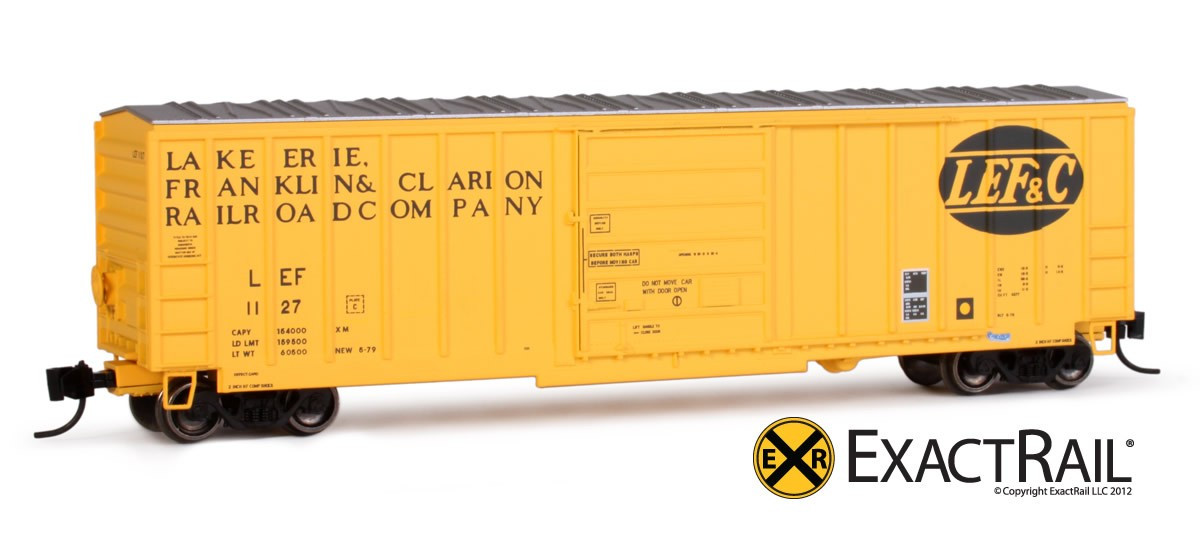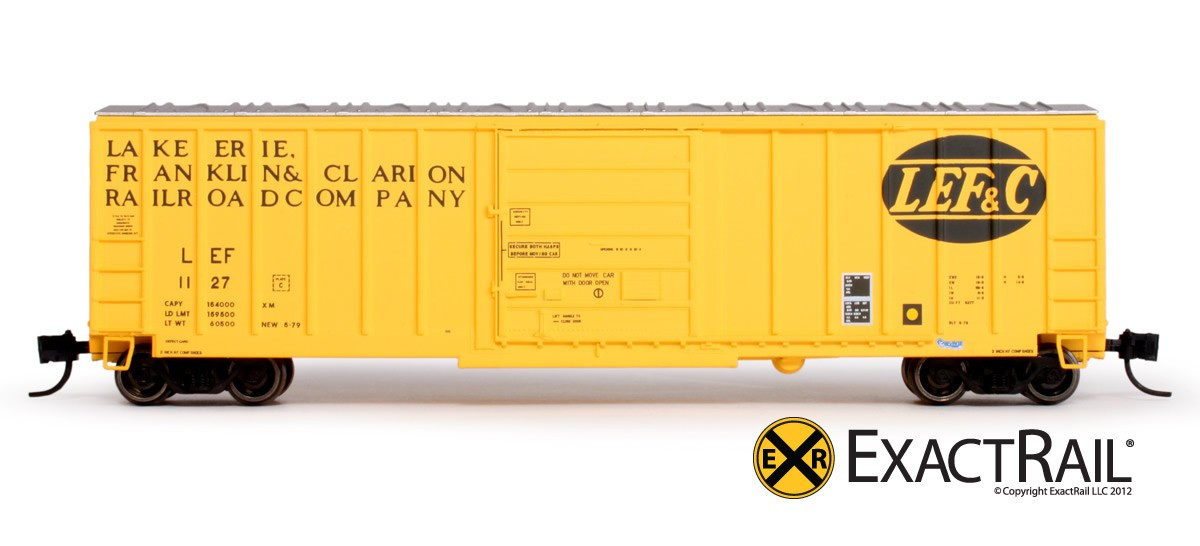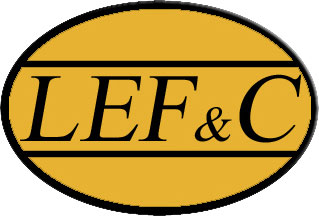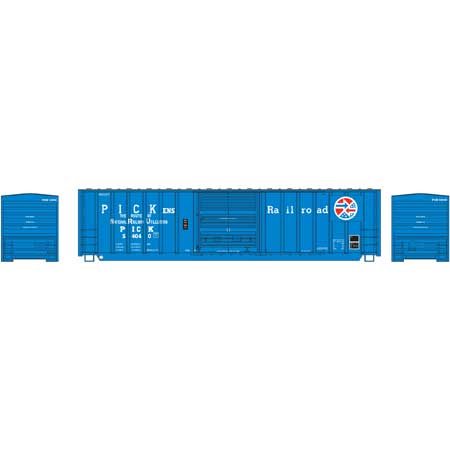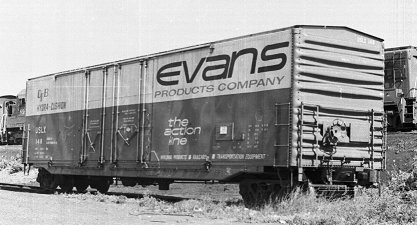Prototype History: With the Per Diem rules implemented by the US government to encourage railroads to purchase more boxcars, boxcar manufacturing roared into gear in the 1970s. Every major manufacturer cranked out 50 foot boxcars to satisfy the demand. Evans was no exception. Empowered by its acquisition of United States Railway Equipment (USRE), Evans-USRE boxcars became ubiquitous during the IPD boxcar boom of the 1970s. With modern upgrades such as box-corrugated, non-terminating ends, Stanray X-panel overhanging roof, and riveted car sides near the end posts, the Evans-USRE 5277 is a classic boxcar of the IPD era.
The former Evans railcar repair facility in Springfield OR is now owned/operated by Gunderson.
The former Evans railcar repair facility in Springfield OR is now owned/operated by Gunderson.
Road Name History: The Lake Erie, Franklin, and Clarion Railroad (reporting mark LEF) was a fifteen mile long short line that ran from a Conrail connection at Summerville, Pennsylvania, to Clarion, Pennsylvania, the county seat of Clarion County, and included a short branch from Sutton to Heidrick. The road was incorporated in 1913 as a consolidation of several other railroads, the Pennsylvania Northern, Pennsylvania Southern, and the Pittsburgh, Clarion and Franklin, which itself was formed from the Pittsburgh, Summerville, and Clarion [which began operation in 1904 and was leased to the Pennsylvania Southern in 1910. Length peaked at about 80 miles of track in around 1924. The corporate name was somewhat optimistic: the railroad never reached either Franklin or Lake Erie.
In the late 20th century, traffic included sand for Clarion's glass making plant, glass bottles, lumber, and outbound shipments of coal, some of it in unit trains from the extensive coal deposits around Clarion. Traffic also included brick from the Hanley Brick Plant in Summerville. The line ceased operation in the last decade of the 1900s due to a sharp decline in coal mining in the area. The track was taken up and the roadbed in now a hiking path. One of the railroad's cabooses had been used for several years as a Chamber of Commerce roadside information booth across the highway from the local Wal-Mart, but has been removed and is now serving much the same purpose in the town of Foxburg on the Allegheny River, a few miles to the southwest.
The line's yard and engine facility were located in Clarion, just south of U.S. route 322 and behind many of the buildings of Clarion University of Pennsylvania, formerly Clarion State Teachers' College. A section house was located at the siding to Hanley Brick, now Glen-Gary in Summerville. Motive power in the line's final years was four EMD MP15DC switchers #25-28, which replaced two earlier EMD SW1500s #23-24. During the final years when steam locomotives powered LEF&C trains, most of the road's locomotives were 2-8-0's which had been acquired second hand from other railroads.
In the late 20th century, traffic included sand for Clarion's glass making plant, glass bottles, lumber, and outbound shipments of coal, some of it in unit trains from the extensive coal deposits around Clarion. Traffic also included brick from the Hanley Brick Plant in Summerville. The line ceased operation in the last decade of the 1900s due to a sharp decline in coal mining in the area. The track was taken up and the roadbed in now a hiking path. One of the railroad's cabooses had been used for several years as a Chamber of Commerce roadside information booth across the highway from the local Wal-Mart, but has been removed and is now serving much the same purpose in the town of Foxburg on the Allegheny River, a few miles to the southwest.
The line's yard and engine facility were located in Clarion, just south of U.S. route 322 and behind many of the buildings of Clarion University of Pennsylvania, formerly Clarion State Teachers' College. A section house was located at the siding to Hanley Brick, now Glen-Gary in Summerville. Motive power in the line's final years was four EMD MP15DC switchers #25-28, which replaced two earlier EMD SW1500s #23-24. During the final years when steam locomotives powered LEF&C trains, most of the road's locomotives were 2-8-0's which had been acquired second hand from other railroads.
Brand/Importer Information: Dedicated to creating replicas that continue to define standards for precision and authenticity, through its unique expertise in mold creation and product design, Provo, Utah based ExactRail has produced some of the industry's most acclaimed models; true benchmarks for quality over the last decade.
With the N-Scale Series, ExactRail offers precision micro-tooled replicas in 1:160 scale. Each model features fine-scale detail, expert hand-assembly and the finest finish-work in the industry. ExactRail's N-scale Series offers enthusiasts innovative small scale replicas with unprecedented quality and design.
With the N-Scale Series, ExactRail offers precision micro-tooled replicas in 1:160 scale. Each model features fine-scale detail, expert hand-assembly and the finest finish-work in the industry. ExactRail's N-scale Series offers enthusiasts innovative small scale replicas with unprecedented quality and design.
Item created by: nscalemodeler160 on 2016-08-20 22:58:40. Last edited by gdm on 2018-02-16 10:29:13
If you see errors or missing data in this entry, please feel free to log in and edit it. Anyone with a Gmail account can log in instantly.
If you see errors or missing data in this entry, please feel free to log in and edit it. Anyone with a Gmail account can log in instantly.


